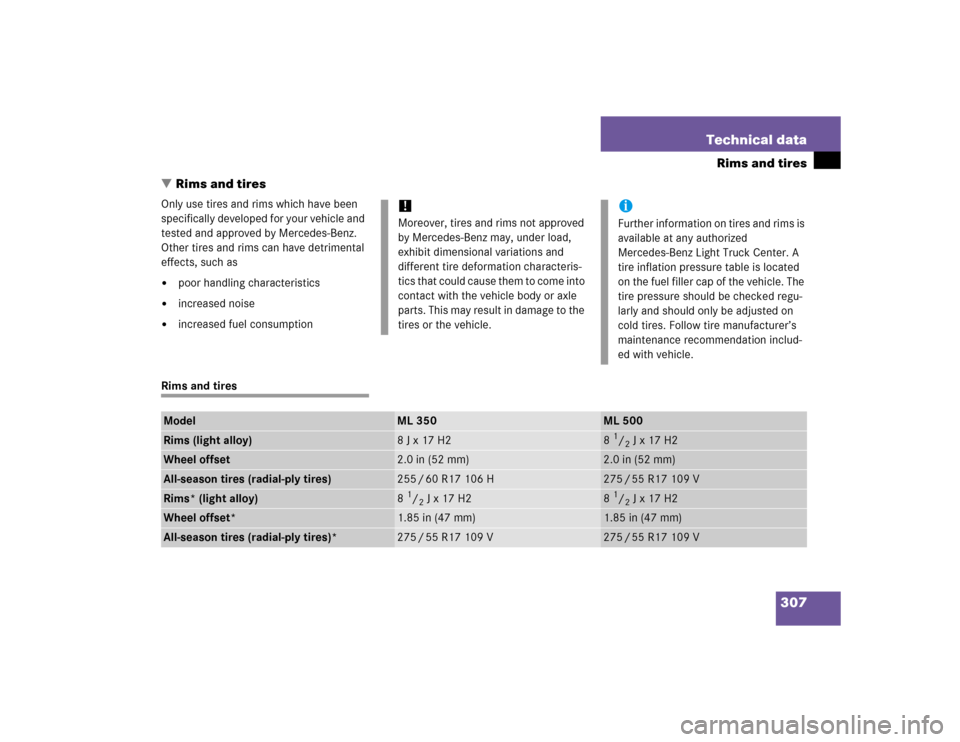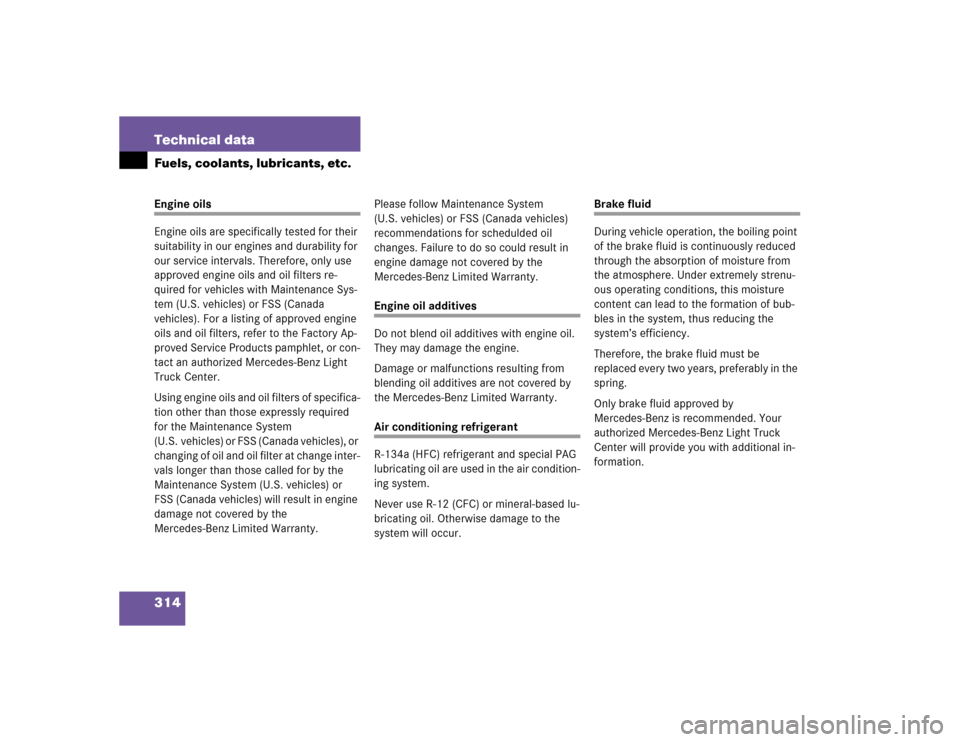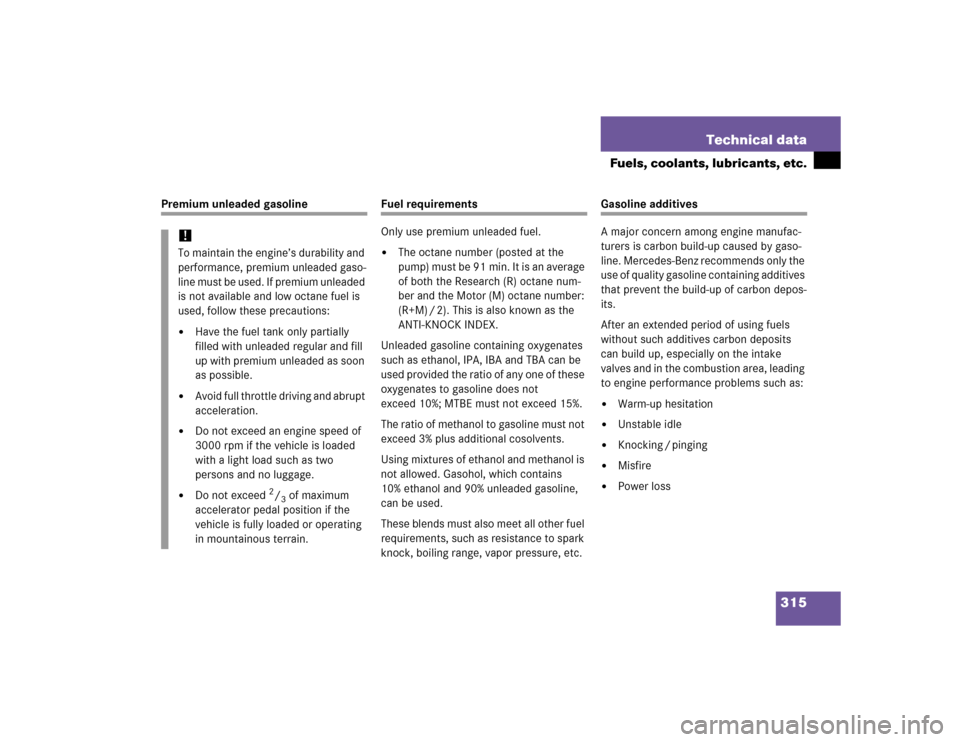Page 303 of 356
301 Technical data
Parts service
Warranty coverage
Identification labels
Layout of poly-V-belt drive
Engine
Rims and tires
Electrical system
Main Dimensions
Weights
Fuels, coolants, lubricants, etc.
Consumer information
Page 308 of 356
306 Technical dataEngineModel
ML 350 (163.157
1)
1The quoted data apply only to the standard vehicle. See an authorized Mercedes-Benz Light Truck Center for the corresponding data of all special bodies and special
equipment.
ML 500 (163.175)
1
Engine
112
113
Mode of operation
4-stroke engine, gasoline injection
4-stroke engine, gasoline injection
No. of cylinders
6
8
Bore
3.81 in (97.00 mm)
3.81 in (97.00 mm)
Stroke
3.31 in (84.00 mm)
3.31 in (84.00 mm)
Total piston displacement
227 cu in (3724 cm
3)
303 cu in (4966 cm
3)
Compression ratio
10:1
10:1
Output acc. to SAE J 1349
232 hp / 5750 rpm
2
(173 kW / 5750 rpm)
2Premium fuel required. Performance may vary with fuel octane rating.
288 hp / 5600 rpm
2
(215 kW / 5600 rpm)
Maximum torque acc. to SAE J 1349
254 lb-ft / 3000-4500 rpm
(345 Nm / 3000-4500 rpm)
325 lb-ft / 2700 rpm
(440 Nm / 2700 rpm)
Maximum engine speed
6000 rpm
6000 rpm
Firing order
1-4-3-6-2-5
1-5-4-2-6-3-7-8
Poly-V-belt
2 370 mm
2370 mm
Page 309 of 356

307 Technical data
Rims and tires
�Rims and tires
Only use tires and rims which have been
specifically developed for your vehicle and
tested and approved by Mercedes-Benz.
Other tires and rims can have detrimental
effects, such as�
poor handling characteristics
�
increased noise
�
increased fuel consumption
Rims and tires
!Moreover, tires and rims not approved
by Mercedes-Benz may, under load,
exhibit dimensional variations and
different tire deformation characteris-
tics that could cause them to come into
contact with the vehicle body or axle
parts. This may result in damage to the
tires or the vehicle.
iFurther information on tires and rims is
available at any authorized
Mercedes-Benz Light Truck Center. A
tire inflation pressure table is located
on the fuel filler cap of the vehicle. The
tire pressure should be checked regu-
larly and should only be adjusted on
cold tires. Follow tire manufacturer’s
maintenance recommendation includ-
ed with vehicle.
Model
ML 350
ML 500
Rims (light alloy)
8J x 17 H2
81/2J x 17 H2
Wheel offset
2.0in (52mm)
2.0in (52mm)
All-season tires (radial-ply tires)
255 / 60 R17 106 H
275 / 55 R17 109 V
Rims* (light alloy)
81/2 J x 17 H2
81/2 J x 17 H2
Wheel offset*
1.85 in (47 mm)
1.85 in (47 mm)
All-season tires (radial-ply tires)*
275 / 55 R17 109 V
275 / 55 R17 109 V
Page 314 of 356
312 Technical dataFuels, coolants, lubricants, etc.Capacities
Vehicle components and their respective
lubricants must match.Therefore only use products tested and
approved by Mercedes-Benz.Please refer to the Factory Approved
Service Products pamphlet, or inquire at
your Mercedes-Benz Light Truck Center.
Model
Capacity
Fuels, coolants, lubricants, etc.
Engine with oil filter
ML 350, ML 500
8.5 US qt (8.0 l)
Approved engine oils
Automatic transmis-
sion
9.0 US qt (8.5 l)
MB Automatic Transmission Oil
Transfer case
1.6 US qt (1.5 l)
(Dexron 3 or Dexron 2E)
Rear axle
1.3 US qt (1.25 l)
(Hypoid gear oil SAE 90, 85 W 90)
Front axle
1.2 US qt (1.1 l)
(Hypoid gear oil SAE 90)
Power steering
approx. 0.65 US qt (0.6 l)
MB Power Steering Fluid
Front wheel hubs
approx. 1.5oz (43g) each
High temperature roller bearing grease
Page 315 of 356
313 Technical data
Fuels, coolants, lubricants, etc.
Model
Capacity
Fuels, coolants, lubricants, etc.
Cooling system
approx. 12.7 US qt (12.0 l)
MB Anticorrosion / Antifreeze
Fuel Tank
including a reserve of
ML 350, ML 500
22.0 US gal (83.0 l)
approx. 3.2 US gal (12.0 l)
Premium unleaded gasoline:
Minimum Posted Octane 91
(Avg.of96RON/86MON)
Air conditioning system
R-134a refrigerant and special PAG lubricant oil
(never R-12)
Windshield washer and
headlamp cleaning
system*
8.0 US qt (7.6 l)
MB Windshield Washer Concentrate
1
1Use MB Windshield Washer Concentrate “S” and water for temperatures above freezing or MB Windshield Washer Concentrate “S” and commercially available
premixed windshield washer solvent / antifreeze for temperatures below freezing. Follow suggested mixing ratios (�page 319).
Page 316 of 356

314 Technical dataFuels, coolants, lubricants, etc.Engine oils
Engine oils are specifically tested for their
suitability in our engines and durability for
our service intervals. Therefore, only use
approved engine oils and oil filters re-
quired for vehicles with Maintenance Sys-
tem (U.S. vehicles) or FSS (Canada
vehicles). For a listing of approved engine
oils and oil filters, refer to the Factory Ap-
proved Service Products pamphlet, or con-
tact an authorized Mercedes-Benz Light
Truck Center.
Using engine oils and oil filters of specifica-
tion other than those expressly required
for the Maintenance System
(U.S. vehicles) or FSS (Canada vehicles), or
changing of oil and oil filter at change inter-
vals longer than those called for by the
Maintenance System (U.S. vehicles) or
FSS (Canada vehicles) will result in engine
damage not covered by the
Mercedes-Benz Limited Warranty.Please follow Maintenance System
(U.S. vehicles) or FSS (Canada vehicles)
recommendations for schedulded oil
changes. Failure to do so could result in
engine damage not covered by the
Mercedes-Benz Limited Warranty.
Engine oil additives
Do not blend oil additives with engine oil.
They may damage the engine.
Damage or malfunctions resulting from
blending oil additives are not covered by
the Mercedes-Benz Limited Warranty.Air conditioning refrigerant
R-134a (HFC) refrigerant and special PAG
lubricating oil are used in the air condition-
ing system.
Never use R-12 (CFC) or mineral-based lu-
bricating oil. Otherwise damage to the
system will occur.
Brake fluid
During vehicle operation, the boiling point
of the brake fluid is continuously reduced
through the absorption of moisture from
the atmosphere. Under extremely strenu-
ous operating conditions, this moisture
content can lead to the formation of bub-
bles in the system, thus reducing the
system’s efficiency.
Therefore, the brake fluid must be
replaced every two years, preferably in the
spring.
Only brake fluid approved by
Mercedes-Benz is recommended. Your
authorized Mercedes-Benz Light Truck
Center will provide you with additional in-
formation.
Page 317 of 356

315 Technical data
Fuels, coolants, lubricants, etc.
Premium unleaded gasoline
Fuel requirements
Only use premium unleaded fuel.�
The octane number (posted at the
p um p) m us t be 91 mi n. It i s an a vera ge
of both the Research (R) octane num-
ber and the Motor (M) octane number:
(R+M) / 2). This is also known as the
ANTI-KNOCK INDEX.
Unleaded gasoline containing oxygenates
such as ethanol, IPA, IBA and TBA can be
used provided the ratio of any one of these
oxygenates to gasoline does not
exceed 10%; MTBE must not exceed 15%.
The ratio of methanol to gasoline must not
exceed 3% plus additional cosolvents.
Using mixtures of ethanol and methanol is
not allowed. Gasohol, which contains
10% ethanol and 90% unleaded gasoline,
can be used.
These blends must also meet all other fuel
requirements, such as resistance to spark
knock, boiling range, vapor pressure, etc.
Gasoline additives
A major concern among engine manufac-
turers is carbon build-up caused by gaso-
line. Mercedes-Benz recommends only the
use of quality gasoline containing additives
that prevent the build-up of carbon depos-
its.
After an extended period of using fuels
without such additives carbon deposits
can build up, especially on the intake
valves and in the combustion area, leading
to engine performance problems such as:�
Warm-up hesitation
�
Unstable idle
�
Knocking / pinging
�
Misfire
�
Power loss
!To maintain the engine’s durability and
performance, premium unleaded gaso-
line must be used. If premium unleaded
is not available and low octane fuel is
used, follow these precautions:�
Have the fuel tank only partially
filled with unleaded regular and fill
up with premium unleaded as soon
as possible.
�
Avoid full throttle driving and abrupt
acceleration.
�
Do not exceed an engine speed of
3000 rpm if the vehicle is loaded
with a light load such as two
persons and no luggage.
�
Do not exceed
2/3 of maximum
accelerator pedal position if the
vehicle is fully loaded or operating
in mountainous terrain.
Page 318 of 356

316 Technical dataFuels, coolants, lubricants, etc.In areas where carbon deposits may be
encountered due to lack of availability of
gasolines which contain these additives,
Mercedes-Benz recommends the use of
additives approved by us for use on
Mercedes-Benz vehicles. Refer to Factory
Approved Service Products Pamphlet for a
listing of approved product(s). Follow
directions on product label.
Do not blend other specific fuel additives
with fuel. This only results in unnecessary
costs and may be harmful to the engine
operation.
Damage or malfunction resulting from
poor fuel quality or from blending addition-
al fuel additives other than those tested
and approved by us for use on
Mercedes-Benz vehicles listed in the Fac-
tory Approved Service Products Pamphlet
are not covered by the Mercedes-Benz
Limited Warranty.
Coolants
The engine coolant is a mixture of water
and anticorrosion / antifreeze, which
provides:�
Corrosion protection
�
Freeze protection
�
Boiling protection (by increasing the
boiling point)
The cooling system was filled at the factory
with a coolant providing freeze protection
to approximately -35°F (-37°C) and corro-
sion protection.
If the antifreeze mixture is effective to
-22°F (-30°C), the boiling point of the cool-
ant in the pressurized cooling system is
reached at approximately 266°F (130°C).The coolant solution must be used year
round to provide the necessary corrosion
protection and increase boil-over protec-
tion. Refer to Maintenance Booklet for
replacement interval.
To provide important corrosion protection,
the solution must be at least 45%
anticorrosion / antifreeze (equivalent to
freeze protection to approx. - 22°F
[-30°C]). If you use a solution that is more
than 55% anticorrosion / antifreeze (freeze
protection to approx. - 49°F [-45°C]), the
engine temperature will increase due to
the lower heat transfer capability of the so-
lution. Therefore, do not use more than
this amount of anticorrosion / antifreeze.